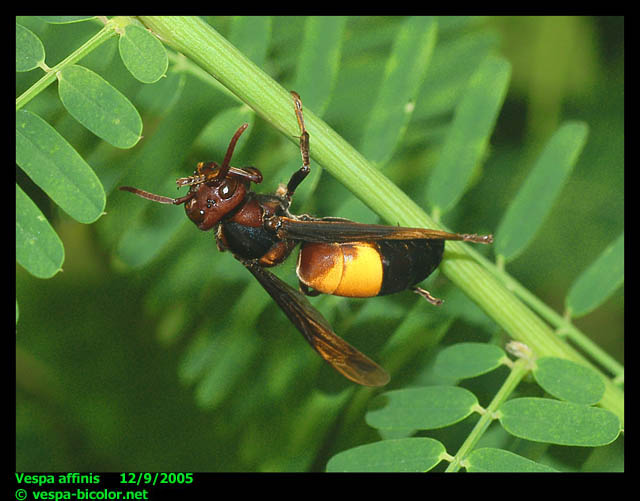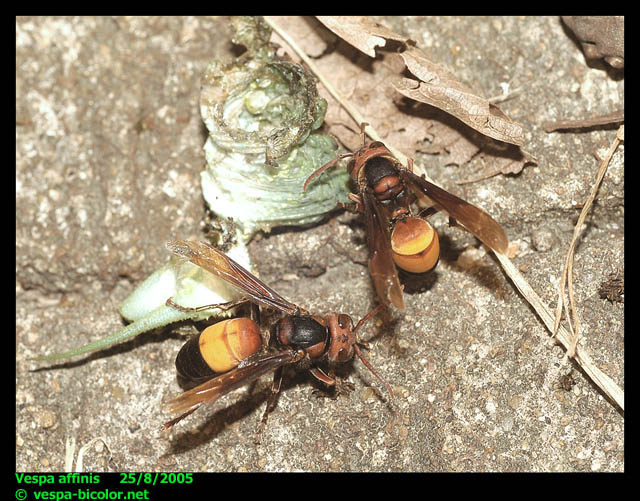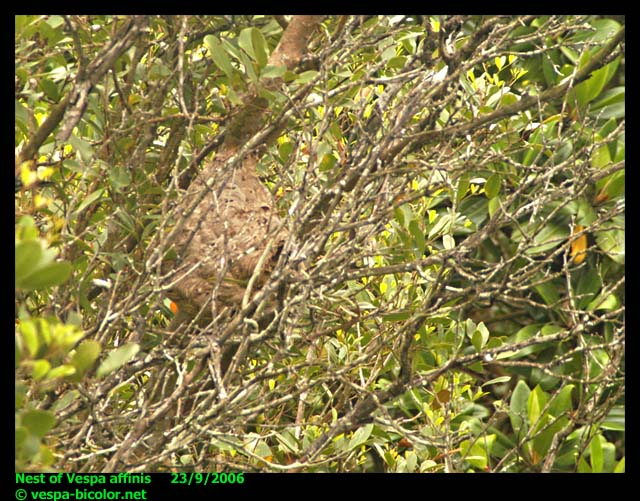
This is a small to medium-sized hornet, with queens reaching 30mm, males 26mm and workers being an average of 22 to 25mm. There are several geographical forms or subspecies; the ones found in Hong Kong and South China are generally mainly black, with the first two abdominal segments being a deep yellow, forming a conspicuous band. The sides of the head and thorax show some reddish brown. On the other hand, specimens from Southeast Asian regions such as Singapore are fully black, without reddish brown markings, and the abdominal band is a brilliant orange.
Above: Vespa affinis in Hong Kong.
Below: Vespa affinis from Singapore

This species is widespread throughout Asia. It can frequently be seen foraging close to the ground in grassy areas, forest and wasteland. This species seems to prey heavily on flies which can be pests. In Singapore, it can frequently be found on the beach, staying near rotting mussels which smell bad and attract flies. Initially, I assumed they were taking the mussel meat to feed their larvae, but it turned out that they were simply creeping into the mussel shells and hiding there to ambush the flies! They also love the nectar from flowers of the coconut tree, and often, after drinking their fill, conveniently grab a honeybee from a nearby flower and head for home. Besides these, they will also attack any small insect they can overpower. They will also collect meat from freshly dead insects.

The nest of Vespa affinis may be built high in a tree, although nests are also commonly found lower in small trees and in and around houses. Nests built in high trees are generally elongated, and look similar to the nest of Vespa velutina. However, they can be distinguished by having a more imbricate nest envelope (many individual overlapping circular layers of papering, as opposed to running vertically lengthwise), and the nest has a tough, durable appearance. It can often reach 60 cm in length in sub-tropical areas, and even larger in true tropical regions. Also, there is an interesting variation of nest shapes; in tropical areas, the top of the nest is very narrow but tapers out downwards, forming a "pear-shaped" or "drop-shaped" structure. Nests in subtropical regions are simply oval with a rounded top. Nest built lower in smaller trees or buildings usually stay round and do not attain such large sizes. In Hong Kong, this species has an average life cycle; the queens awake from hibernation in April, and the colony usually dies only in late November or December. In fully tropical areas, it seems present all the time. This species is known for multiple queen founding or even swarm founding (known in scientific terms as pleometrosis) in tropical regions, where several queens or multiple queens with a swarm of workers from the old colony start a new nest together.
The photos below show a nest of this species, cut open to reveal four combs. Note the texture of the nest envelope. Also note that many nests of this species get very large, similar to nests of Vespa velutina and Vespa simillima. Some larger nests easily contain seven to ten such combs!
Photos copyright and courtesy of Christophe Barthelemy (Hong Kong).



Above: A very large nest in Singapore, built in a very tall tree.
Below: A mid-stage nest inside an abandoned hen-house in a rural village in Hong Kong.

In my experience, Vespa affinis is not particularly defensive near the nest, and it is in fact possible to approach and observe a nest at close range. However, large numbers of workers will swarm out and attack pugnaciously when the nest is disturbed. From personal experience, Vespa affinis in Singapore, although still approachable, seem more alert and ready to attack near the nest than their Hong Kong counterparts, and once provoked, attack in larger numbers and give chase over longer distances. The same appears to be true of Vespa tropica. Possibly, larger colony sizes and constant hot weather cause most wasps to be more defensive in tropical regions.
In most parts of its range, Vespa affinis can easily be distinguished from Vespa tropica by its smaller size and the distribution of the yellow band on the abdomen; the yellow band covers the first and second segments in Vespa affinis, but only the second in Vespa tropica.